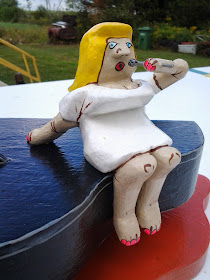The legs of the piano are pieces of old spindle. It measures 14" long.
"HANDS ON: ALIENS IN THE ATTIC. Wacky, fun, iconoclastic--these are the hallmarks of a folk artist, and P.E.I. Native Kerras Jeffery has them in spades". NATIONAL POST Jan/2011
Friday, August 29, 2014
Piano Player & Songstress
This is a man playing his piano with his singing friend perched on top!
The legs of the piano are pieces of old spindle. It measures 14" long.
The legs of the piano are pieces of old spindle. It measures 14" long.
Friday, August 22, 2014
Parrot
I've made parrots before using a lobster claw for the beak but thought
this sea shell (some I got two years ago) - would make an even better beak. For the base I just went upstairs over my studio to "Grandmas Attic" and found a few different styles. The overall height is 18".
Below is a glimpse into Grandma's Attic - ya gotta come see it in person.
Friday, August 15, 2014
Folk Art Ferris Wheel
About a month ago a dealer came to see me - in the back of his truck he had a folk
at Ferris wheel made of plywood. It got me thinking how I could do one.
I had the idea of using using bike rims for the wheel - they worked out great. I used a hand drill for the turning mechanism and wrapped a bungy chord around the wheel.
The carvings and basket sets are all carved from wood.
I had the idea of using using bike rims for the wheel - they worked out great. I used a hand drill for the turning mechanism and wrapped a bungy chord around the wheel.
The carvings and basket sets are all carved from wood.
Check-out this video...
What about the Ferris Wheel? The first "Ferris Wheel" was erected at the Worlds Columbian Exhibition in Chicago in 1893 - it weighed 71 tons and had a 45.5-foot axle and could carry as many as 2,160 people. It was designed by George W.G. Ferris Jr. - a Pittsburgh bridge builder.
Tuesday, August 5, 2014
Monday, August 4, 2014
Cottage style Coffee Table
I made this coffee table for a Nova Scotia customer - it's the longest coffee table I've made yet, measuring 32"x60". I make them any size - large or small.
I always say I build these tables strong enough you can dance on them.
I always say I build these tables strong enough you can dance on them.
Saturday, August 2, 2014
Coffee Tables made from sand casting wood molds
I picked up these wood molds yesterday from a Nova Scotia dealer. He said they are sand casting molds used in iron making from the Trenton Ironworks (now closed) in Trenton, Nova Scotia.
I made these coffee tables from the molds.
On the red coffee table I used a set of clawfoot bathtub feet; and on the yellow coffee table I used an old water tank stand that would have stood behind a wood stove.
The tables measure 30" wide.


I made these coffee tables from the molds.
The tables measure 30" wide.
Here's information about Trenton Ironworks from Wikipedia.
TrentonWorks is an
industrial manufacturing facility located in the town of Trenton, Nova Scotia, Canada. this collection of factories on the bank of
the East River of Pictou has witnessed a large variety of industrial
operations, ranging from steel making (the first steel plant in Canada),
rolling mills, forging, shipbuilding, munitions manufacturing, rivets and
bolts, and most recently (and longest lasting) rail cars.
The
extensive plant is being converted to manufacture wind turbine components for
South Korean industrial conglomerate Daewoo
Shipbuilding & Marine Engineering in its
first foray into North America; this is being made possible through
corresponding investments by both the Government of Nova Scotia and the
Government of Canada.
Below image cf. www.doncoshhistoryoftrenton.blogspot.ca
Here’s
some information about sand casting.
Sand casting is used to make large parts
(typically Iron, but also Bronze, Brass, Aluminum). Molten metal is poured into
a mold cavity formed out of sand (natural or synthetic). The processes of sand
casting are discussed in this section, include patterns, sprues and
runners, design
considerations, and casting
allowance. The cavity in the
sand is formed by using a pattern (an approximate duplicate of the real part),
which are typically made out of wood, sometimes metal. The cavity is contained
in an aggregate housed in a box called the flask. Core is a sand shape inserted
into the mold to produce the internal features of the part such as holes or
internal passages. Cores are placed in the cavity to form holes of the desired
shapes. Core print is the region added to the pattern, core, or mold that is
used to locate and support the core within the mold. A riser is an extra void
created in the mold to contain excessive molten material. The purpose of this
is feed the molten metal to the mold cavity as the molten metal solidifies and
shrinks, and thereby prevents voids in the main casting.
Typical
Components of a Two-part Sand Casting Mold.














































